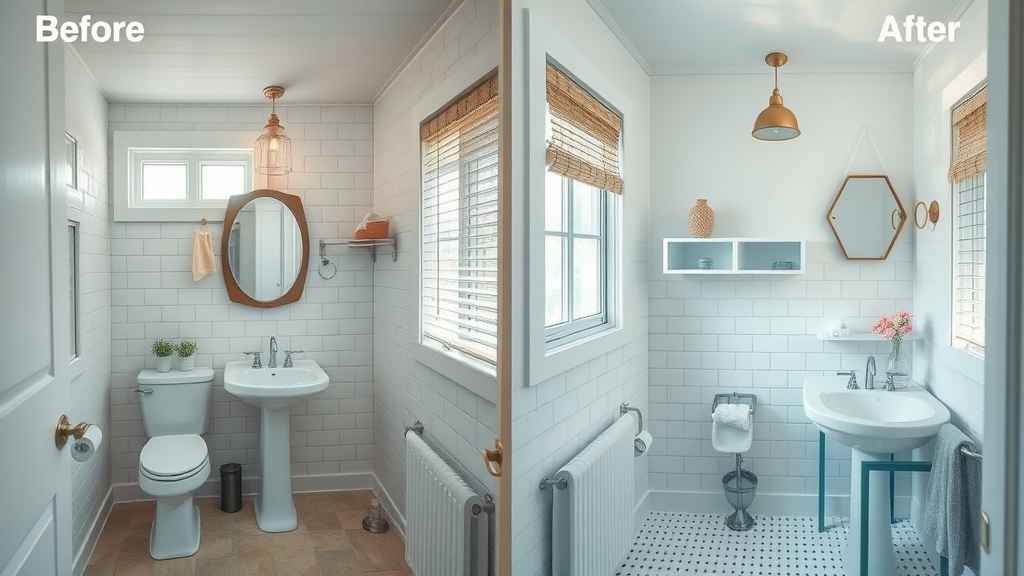Did you know that luxury bathroom upgrades can boost your home’s value by over 10%? Enhancing your space isn’t just about aesthetics—it’s a smart investment that combines comfort with increased resale potential. Discover which upgrades truly transform your bathroom into a lavish retreat.Why Luxury Bathroom Upgrades Are a Smart InvestmentLuxury bathroom upgrades are far more than fleeting design trends—they are strategic investments that reshape everyday routines while dramatically enhancing your home’s market value. Today’s home buyers place high priority on spa-inspired, thoughtfully designed bathrooms, making these spaces a key factor in resale decisions. Whether you’re considering a full-scale bathroom remodel or targeted luxury bathroom remodel ideas, each thoughtful upgrade can distinguish your property from the competition.“A luxury bathroom doesn’t just enhance comfort—it increases home value and buyer appeal.” — Lincoln BirdModern bathroom remodels that focus on premium finishes, smart technology, or clever storage solutions don’t just feel amazing—they’re among the most cost-effective improvements for ROI, especially in the primary bath. Importantly, luxury bathroom upgrades cater to every style: from minimalist sanctuaries to bold, statement-driven home design. Each change you implement not only enhances day-to-day comfort but contributes to a dream bathroom that stands out in photos, showings, and appraisals.Top Bathroom Remodel Ideas to Transform Your Space TodayExploring bathroom remodel ideas is a fantastic way to elevate your home’s comfort and style. Consider a modern bathroom update with walk-in showers and double vanities, or opt for luxury features like heated floors and freestanding tubs. Every guest bath, powder room, or primary bath can benefit from such thoughtful details. Start with clean lines and durable fixtures for timeless elegance and layer in elements that speak to your personal style, such as bold lighting or natural stone. Even small changes can make a significant impact, ensuring your bathroom design is a true reflection of your unique taste and needs.Beyond aesthetics, the right bathroom remodel idea improves everyday functionality. Incorporate storage-focused custom cabinetry, streamline grooming zones with floating vanities, or use high-tech amenities for added convenience and sophistication. Each feature enhances both visual allure and usability, instantly transforming an ordinary bathroom into a modern, luxurious retreat.What You'll Learn About Luxury Bathroom UpgradesTop luxury bathroom upgrades and their impact on property valueModern bathroom remodel ideas for any size or styleHow to incorporate spa-like elements for a luxury bathroom remodelTips for maximizing natural light and style in your primary bathExpert recommendations for boosting bathroom design Transform Your Powder Room: Stylish Ideas and Expert TipsIf you crave sophistication but have limited square footage, your powder room presents the perfect opportunity for a dramatic luxury bathroom remodel. Elegant wallpaper, chic lighting fixtures, or bold paint colors set a stylish tone in this smaller space. Add a petite vanity with eye-catching hardware, and consider built-in custom cabinetry for hidden storage. Natural light can make even the most compact bathroom feel airy and inviting—opt for statement mirrors or glass shelving to reflect light and maximize visual space.Don’t overlook accessories in your powder room’s bathroom design: think decorative trays, luxury soap dispensers, and plush towels for a five-star guest bath experience. Even in tight quarters, high-quality finishes and thoughtful layout can make the powder room feel like a tiny boutique spa, adding both charm and surprising value to your home.1. Spa-Inspired Showers: The Ultimate Luxury Bathroom UpgradeOf all luxury bathroom upgrades, few rival the transformative power of a spa-inspired shower. Imagine stepping into a spacious, walk-in shower enveloped in calming tile textures, the air misted by a gentle rain showerhead. Modern bathroom remodel ideas often prioritize these showers for their ability to merge relaxation and function. High-end features like built-in seating, steam options, and advanced digital controls elevate your routine, turning the everyday into a rejuvenating ritual. Spa showers instantly enhance the primary bathroom, becoming a coveted highlight when it’s time to sell.Expert interior designers recommend glass enclosures and minimalist hardware for a fresh, contemporary look that makes small bathrooms appear larger. Spa showers are notable for both their visual impact and practical advantages, including accessible design and easier cleaning. New bathroom remodel ideas consistently rank luxury showers among the best ways to improve a home’s value, underscore style, and support wellness in your daily life.Designing a Modern Bathroom with Walk-In ShowersA modern bathroom with a walk-in shower is the epitome of refined living, offering clean lines and a seamless aesthetic that’s customizable for any bathroom size. Use glass panels to create an open, airy environment, while bold tile selections and customized storage niches bring designer flair. For those with square footage constraints, consider a curbless walk-in design, which enhances accessibility and fosters a spacious feel. Features like brushed gold fixtures or matte black hardware can elevate your bathroom design, catering to both traditional and contemporary tastes.Incorporate built-in benches, rainfall showerheads, and programmable LED accent lighting for a layered look. Pairing these upgrades with natural light sources—like a statement window or skylight—makes the shower experience truly spa-worthy. With careful planning, even the guest bath or powder room can be transformed using these remodel ideas, reinforcing the luxurious ambiance throughout your home. Bathroom Remodel Ideas: Rain Showerheads & Digital ControlsRain showerheads and digital shower controls are considered essential luxury bathroom upgrades for a modern bathroom. These features offer the ultimate in comfort and convenience, with the ability to fine-tune water pressure, temperature, and lighting at the touch of a button or via a voice command. Digital systems allow for personalized presets, so each member of the household can enjoy their preferred shower experience. These technologically advanced features not only enhance showering, but also boost the resale value of your property, appealing to tech-savvy buyers and those seeking a luxury bathroom remodel.For added sophistication, pair rain showerheads with wall-mounted body jets, aromatherapy infusers, or built-in Bluetooth sound systems. By integrating smart controls and stylish plumbing fixtures, you create a truly immersive daily escape. Such upgrades transform the primary bath, elevating your home design and making a statement to all who enter.2. Standalone Tubs—the Centerpiece of Modern Bathroom RemodelsFew features capture the essence of a luxury bathroom upgrade quite like a standalone tub. Freestanding designs deliver high-impact, five-star hotel chic and serve as a stunning sculptural focal point for any primary bath or guest suite. Whether your design inspiration is classic clawfoot or crisp, modern lines, a deep soaking tub invites indulgent relaxation while conveying a sense of abundance and well-being. Luxury bathroom remodels increasingly rely on statement tubs to ground the entire space and showcase expert interior design.Standalone tubs are more than style statements; they maximize square footage by allowing flexible placement, making them ideal for awkward or unusual layouts. Pair your tub with a designer side table, glamorous floor-mounted filler, and plush surround textiles for a complete high-end look in your dream bathroom. The result is a showstopper that delivers comfort and immediate buyer appeal.Deep Soaking and Freestanding Tub Luxury Bathroom Remodel OptionsDeep soaking tubs and freestanding designs are top choices among luxury bathroom remodels for their superior comfort and sculptural beauty. Soaking tubs, often crafted from elegant materials like stone, cast iron, or acrylic, offer thermal retention and ergonomic curves for a spa-caliber experience. Freestanding tubs work well in both large primary bathrooms and cozy guest baths; consider a compact oval for tighter quarters or a bold, angular shape for modern bathroom drama.Choose accent pieces such as a minimalist side table for candles, a stylish tub tray for bath accessories, or floor-mounted fixtures in trendy metallic finishes. These details reveal your personal style while supporting a high-functioning, user-friendly environment. For extra luxury, position the tub to capture natural light through floor-to-ceiling windows or under a striking light fixture, transforming bath time into a soothing ritual.Primary Bath Focal Points with Statement TubsA statement tub is more than a bathing vessel—it’s a commanding centerpiece for your primary bath. From classic slipper tubs to minimalist, rectangular soakers, the right choice can set the tone for your entire bathroom remodel idea. Use striking materials like matte stone or polished marble for an on-trend look that stands the test of time. Surround your tub with serene surfaces such as open shelves or floating vanities to keep the bathroom feeling organized and airy.Expert designers suggest anchoring your tub near abundant natural light to maximize impact and enjoyment. Layer in accessories—think fresh plants, custom cabinetry, and easy-to-reach heated floors—to complete your luxury bathroom upgrade while ensuring every bath feels like a lavish retreat. Whether you’re tackling a small powder room or an expansive spa bath, statement tubs add value, visual drama, and enduring appeal to any bathroom project.3. Double Vanity Designs for Maximum Style and FunctionalityThe double vanity is a hallmark of modern luxury bathroom remodels and a top contender for boosting style and efficiency. With two sinks and expanded countertop real estate, double vanities eliminate the morning rush and revolutionize storage and organization in the primary bath or upscale guest baths. Whether built-in or floating, their design versatility means they can be tailored for traditional, transitional, or ultra-modern bathroom layouts, amplifying both value and convenience.Today’s trend-driven double vanities incorporate premium materials, custom cabinetry solutions, and luxury finishes like quartz counters and high-gloss lacquers. Add finishing touches with under-vanity accent lighting, designer faucets, and oversized mirrors to create an effortlessly polished look that radiates everyday elegance.Functional Bathroom Designs: Storage and Space-Saving Remodel IdeasA beautifully designed bathroom isn’t just about impact; it must function seamlessly for your daily routine. With a double vanity, clever storage abounds: closed cabinets, pull-out trays, and deep drawers help you keep clutter at bay. Maximize every square inch with built-in organizers, maintaining clean lines and a minimalist vibe. Space-saving remodel ideas like mirrored medicine cabinets and nested shelving units ensure that items stay organized and accessible, even for families or frequent guests.Contemporary bathroom remodels increasingly favor floating vanities, which visually expand the space by exposing more floor area and allowing ambient lighting to flow freely. Integrating custom cabinetry beneath sinks and along bathroom walls further enhances storage potential and preserves that coveted luxury bathroom look. These updates work beautifully in both small powder rooms and expansive primary bathrooms.Transform Your Space with Expert Interior Design TipsExpert interior designers agree that thoughtful planning is key to realizing your dream bathroom. Focus on the flow of the room—arrange your double vanity for privacy and optimum accessibility, especially in high-traffic spaces. Choose surfaces that withstand daily wear while showcasing luxury, such as natural stone counters or premium woods. Don’t forget to embrace technology: built-in outlets, soft-close drawers, and ambient LED lighting can all be incorporated for a seamless, up-to-date primary bath.Personal touches, like vessel sinks or metallic hardware, add character. Layered lighting above the vanity area not only spotlights your bathroom’s functionality but also infuses sophisticated style—making every glance in the mirror a reminder of your successful bathroom remodel. Consulting an interior designer ensures your space achieves that careful balance between fashion and function.Discover Stylish Floating Vanities to Elevate Your Bathroom DesignFloating vanities remain a hot trend in luxury bathroom upgrades, prized for their sleek silhouette and space-amplifying effect. By suspending cabinetry above the floor, you introduce a sense of openness and modernity to the bathroom—ideal for rooms of any size. Floating vanities can be customized with integrated lighting, vessel sinks, or waterfall countertops. Their clean lines echo modern bathroom design while their versatile finishes (from wood veneers to glossy lacquers) add rich texture.For maximal functionality, select floating vanities with deep drawers or built-in organizers, providing smart storage without visual bulk. Coordinate your vanity style with the room’s hardware, wall finishes, and light fixtures for a cohesive designer look. This upgrade is especially effective in powder rooms and smaller spaces—instantly elevating the entire setting while boosting home value. Luxury Finishes for Your Double Vanity UpgradeThe appeal of a luxury bathroom upgrade often hinges on the quality of finishes chosen for vanities. Premium materials like quartz, granite, or solid surface counters enhance durability and impart an opulent look. Consider faucets and handles in brushed gold, matte black, or polished chrome for an on-trend edge. Mirrors with integrated lights and anti-fog tech add sophistication and usability to your space.Textured tile backsplashes, soft-close cabinetry, and distinctive hardware reinforce the sense of luxury while holding up to daily use. Don’t overlook minimalist decor—fresh towels, bouquet vases, or artisan soap dispensers can provide a touch of hotel-style luxury in even the hardest-working bathroom remodels.4. Maximizing Natural Light for an Airy Luxury BathroomNatural light is a crucial element of modern bathroom design, transforming even small spaces into inviting sanctuaries. Maximizing light in your luxury bathroom remodel has the power to brighten colors, highlight high-end materials, and make your space feel cleaner and more expansive. Large windows, glass doors, and reflective surfaces are excellent ways to augment sunlight. If your bathroom walls don’t permit window expansion, consider a skylight or sun tunnel for an instant mood boost in your primary bath or powder room.Harnessing daylight not only enhances aesthetics but also supports wellness by syncing your daily routine with natural rhythms. Coordinated with clever bathroom remodel ideas like glass shower enclosures, shimmering wall tiles, or strategically placed mirrors, the added light achieves a designer look that is both uplifting and energy efficient.Ideas for Adding Skylights and Statement WindowsAdding a skylight or oversized window can be the defining feature of your luxury bathroom upgrade. Skylights flood your bathroom with sunlight, making the primary bath feel open and spa-like. Consider installing a statement window near your soaking tub or walk-in shower to visually extend space, let in tranquil garden views, or simply make the most of limited square footage. Opt for privacy glass or frosted panes where needed, balancing light with discretion.To maximize impact, pair these features with light-reflecting tiles and delicate window treatments. Lush green plants by the bath or sleek benches under a large window reinforce the oasis vibe, ensuring your bathroom design is as functional as it is photogenic. With the right remodel idea, even urban bathrooms can glow with the beauty of natural light. Integrating Smart Lighting in Bathroom RemodelingIntegrating smart lighting into your bathroom remodeling plan allows you to replicate the effects of natural sunlight at any hour. Digital controls let you adjust brightness and color temperature, creating the perfect ambiance for any bathroom task—whether you’re preparing for the day or winding down in your primary bath. Sensor-based switches and dimmers add energy efficiency and modern flair, while light strips under cabinets or mirrors bring subtle luxury to bathroom walls.Expert bathroom designers suggest layering overhead, task, and accent lighting to achieve the ultimate in style and usability. This combination ensures your bathroom always looks—and feels—spectacular, regardless of the hour or the weather.Top Light Fixtures to Brighten Your Space with StyleChoosing the right light fixture is essential for a successful luxury bathroom remodel. Statement chandeliers, sculptural sconces, and backlit mirrors are popular choices that boost both illumination and visual interest. Chrome, glass, and brass finishes work with a range of bathroom designs, from glam powder rooms to serene minimalist retreats. Look for fixtures with integrated LEDs for long-term efficiency and easy maintenance.Strategically place fixtures to minimize shadows and glare on work surfaces, enhancing both beauty and task performance. Layer in floor or wall lighting for added depth, creating a layered look that showcases the best of contemporary bathroom remodeling.5. High-End Materials for a Luxury Bathroom RemodelWhen it comes to luxury bathroom upgrades, materials matter. High-end selections such as marble, natural stone, and designer tiles instantly elevate your modern bathroom design. These surfaces offer a tactile richness, timeless beauty, and enduring value. Large-format tiles on bathroom walls or floors minimize grout lines and create uninterrupted visual flow—excellent for both spacious primary baths and compact guest baths.Don’t overlook luxury details like custom stone countertops, accent mosaics, or wood-look porcelain for warmth and style. The smartest bathroom remodels strike a balance between signature materials and everyday practicality, resulting in spaces that feel both indulgent and durable.Choosing Premium Tiles, Marble, and StonePremium tiles, whether glossy ceramics or honed marble, provide a sense of sophistication that defines every luxury bathroom remodel. Look for large panels for a seamless look, dramatic veining for bold style, or textured tiles for subtle dimension. Natural stone is prized for its uniqueness—no two slabs are alike, imbuing your bathroom with one-of-a-kind character.Coordinate wall and floor finishes for cohesion, and use stone thresholds or accent strips for custom designer flair. Pair classic materials with contemporary hardware and floating vanities to achieve a refined, fresh take on bathroom design. These materials work particularly well in both primary baths and high-traffic guest baths.Experience Ultimate Comfort with Efficient Heated FloorsHeated floors are quickly becoming a must-have in any modern bathroom remodel. These efficient systems provide gentle warmth underfoot, banishing the chill of tile while enhancing luxury every time you step into your bathroom. Best of all, radiant floor heating is energy-efficient—dispersing warmth evenly without the need for noisy forced air.Integrate heated flooring with smart thermostats for instant comfort in your primary bath, guest bath, or powder room. Combined with premium tile or stone, this upgrade ensures your bathroom is both beautiful and inviting year-round, adding a touch of daily decadence and long-term real estate value. Sustainable Luxury—Eco-Friendly Bathroom Remodel IdeasSustainability is an essential theme in today’s luxury bathroom upgrades. Opt for water-saving fixtures, recycled materials, and energy-efficient lighting to reduce your environmental footprint without sacrificing style. Reclaimed wood vanities, low-flow toilets, and green-certified tiles all offer eco-friendly alternatives for a conscious modern bathroom remodel.Smart design choices—like solar-tube skylights or insulated windows—further enhance efficiency, creating a primary bath that is both luxurious and responsible. Increasingly, buyers are prioritizing sustainable upgrades, ensuring these features boost appeal and resale value.6. Smart Tech: The Future of Luxury Bathroom UpgradesThe integration of smart technology is redefining the modern luxury bathroom. Automated fixtures, programmable showers, and voice-activated controls allow for personalized comfort and convenience at the touch of a button—or sound of your voice. From digital mirrors that display news and weather to self-sterilizing toilets, tech-driven features are among the most popular luxury bathroom remodel ideas today.Adopt smart sensors for hands-free faucets, heated floors with Wi-Fi controllers, and intuitive lighting systems that remember your preferences. These upgrades elevate your primary bathroom to cutting-edge levels of comfort, while maximizing efficiency and reducing wasted resources.Automated Fixtures and High-Tech Modern Bathroom FeaturesSmart faucets, automatic flush toilets, and integrated sound systems create an environment that responds to your needs with minimal effort. High-tech features like digital shower controllers, antimicrobial surfaces, and dehumidifying fans contribute to cleaner, more comfortable bathrooms. Automated window shades and privacy glass can be adjusted with your smartphone, offering both convenience and modern elegance.As smart home adoption accelerates, incorporating these luxury bathroom upgrades ensures your space is future-ready, striking a perfect balance of form and function that enhances everything from your morning routine to weekend relaxation.Voice-Activated Controls & Heated FlooringVoice-activated controls are one of the most exciting trends in bathroom design, allowing you to adjust lighting, water temperature, or even play music hands-free. Pairing these with app-controlled heated flooring and climatic zones gives you unprecedented personalization in your luxury bathroom. Such systems are both practical and indulgent, offering tangible comfort and enduring appeal.Integrate these technologies seamlessly by working with an experienced bathroom remodeler or interior designer, ensuring your luxury bathroom upgrades not only look stunning but deliver intuitive, next-level performance.7. Custom Storage Solutions to Enhance Your Bathroom RemodelNo luxury bathroom remodel is complete without custom storage solutions. Carefully designed built-in cabinets and hidden compartments maintain order in even the busiest bathrooms, ensuring beautiful surfaces remain clear of clutter. Custom cabinetry can be tailored to fit awkward spaces, adapt to your storage needs, and blend with your bathroom’s style—whether classic or ultra-modern.Prioritize easy-access drawers beneath vanities, pull-out organizers inside taller cabinets, and elegant, well-lit medicine cabinets for daily essentials. With smart storage in place, your dream bathroom stays serene and functional over time.Built-In Cabinets and Hidden CompartmentsBuilt-in cabinetry brings high style and maximum utility to luxury bathroom upgrades. Floor-to-ceiling storage units, recessed wall niches, and hidden compartments allow you to tuck away everything from toiletries to spare towels. Custom cabinetry can even include electrical outlets, in-drawer organizers, and adjustable shelves for total organization.This approach is ideal in primary baths with high usage or where square footage is at a premium, ensuring every inch is put to use without sacrificing the openness and visual airiness prized in modern bathroom designs.Transform Your Space with Expert Custom Cabinetry SolutionsExpert custom cabinetry combines craftsmanship with creativity, resulting in uniquely tailored bathroom remodel ideas. Work with a reputable interior designer or millworker to create solutions that fit your routines and your room: linen towers, built-in laundry bins, or vanity towers that rise seamlessly alongside double vanities. Choose hardware and finishes that unify your bathroom’s look for a cohesive, luxurious result.Well-designed custom cabinetry can often make even a small powder room feel spacious and organized, fulfilling both aesthetic and functional demands while increasing overall property value.Top Medicine Cabinet Ideas for Organized and Safe StorageMedicine cabinets are essential in any well-organized bathroom, but modern iterations offer far more than simple mirrored doors. Recessed cabinets save space while keeping countertops clear, while lockable units in family homes ensure safety. Backlit mirrors, integrated outlets, and adjustable shelving in today’s models cater to contemporary lifestyles and boost your bathroom’s tech credentials.For a stylish twist, consider medicine cabinets with minimalist frames or custom interiors, complementing the broader luxury bathroom design with understated elegance.Declutter with Smart Bathroom Remodel StorageSmart storage solutions, like pull-out hampers, toe-kick drawers, and floating shelves, help maintain order and enhance the luxury bathroom’s clean lines. When every product has its place, even small spaces achieve that spacious, magazine-worthy look. Incorporate open shelving for display-worthy items, and closed storage for everyday essentials, balancing style with orderliness throughout your bathroom remodel.With thoughtful planning, features like built-in cabinetry and discreet compartments keep your dream bathroom as clutter-free as it is beautiful.8. Statement Lighting: Transforming Your Luxury Bathroom DesignStatement lighting is a game changer in any luxury bathroom upgrade, transforming spaces with a single bold fixture. Eye-catching chandeliers, sculptural sconces, or distinctive pendant lights can anchor the design and set the mood, whether in the powder room or the grandest primary bath. Such lighting choices blend function and style, providing essential illumination while broadcasting your bathroom’s unique character.Incorporate lighting that aligns with the broader palette and materials of your remodel. With layered light sources—ambient, task, and accent—you ensure usability and a high-end designer feel that elevates your daily rituals and the bathroom’s overall appeal.Chandeliers and Sconces for Modern BathroomsChandeliers, once reserved for dining rooms, now find a glamorous home in the luxury bathroom. Placed over a standalone tub or in the bath’s entry, a chandelier becomes a sculptural centerpiece. Modern sconces—especially those with sleek metallic finishes or crystal details—flank vanities for balanced, flattering light that complements mirrors and window views.Whether you prioritize drama or subtlety, pairing unique lighting with impeccably chosen hardware pulls your dream bathroom together, making each morning and evening feel like a luxury experience. Layered Lighting Ideas for Luxury Bathroom RemodelsLayered lighting strategies are vital if you seek a luxury bathroom remodel that sparkles morning and night. Combine recessed ceiling lights for general illumination, decorative pendants or chandeliers for visual impact, and hidden LED strips for ambient mood lighting. Task lights above vanities support grooming while enhancing beauty and utility.Working with an interior designer or lighting specialist helps you create a lighting plan that flatters your space, showcases high-end finishes, and ensures every feature of your modern bathroom remodel shines at its best.9. Luxury Bathroom Upgrade Ideas for Small SpacesTransforming small bathrooms into stylish retreats is possible with savvy luxury bathroom remodel ideas. Floating vanities, oversized mirrors, and glass shower enclosures create the illusion of more space, while compact soaking tubs and pocket doors maximize every inch. Utilize a light color palette, glossy tiles, and streamlined fixtures to open up tight quarters and foster an airy, luxurious feel.Even powder rooms reap huge benefits from these design moves. Mirrors that stretch to the ceiling, wall-mounted faucets, and niche shelving ensure that storage needs are met without sacrificing precious square footage. It’s a winning formula for dreamy bathroom design in homes of any size.Maximizing Style in Compact Bathroom RemodelsCreating style impact in a small bathroom means focusing on clever layout, bold fixtures, and upscale finishes. Use vertical space for storage by installing tall cabinets or wall shelving, and select petite vanities equipped with deep drawers. Large, patterned floor tiles or accent walls provide visual intrigue and help guide the eye upward.Opt for frameless shower screens, reflective surfaces, and built-in lighting to amplify natural brightness and bring an open, modern feel to the room. With these practical remodel ideas, even limited space can become your favorite room in the house.Innovative Remodeling for Urban SpacesUrban living often comes with space constraints—making creative solutions essential in any bathroom remodel idea. Use sliding glass panels to zone wet and dry areas, fold-down benches for multi-purpose use, and mirrored cabinetry to double as storage and illusion.Choose compact versions of luxury staples, like deep soaking Japanese tubs, wall-integrated faucets, or space-saving smart toilets. These updates blend style, comfort, and practicality, ensuring your urban bathroom rivals any luxury hotel spa.10. Trends in Modern Bathroom Remodeling for 2025The landscape of bathroom design is evolving rapidly, with this year’s modern bathroom remodels balancing minimalist luxury with bold statements and integrated smart tech. Buyers are drawn to primary bathrooms that showcase seamless, digital controls, eco-friendly surfaces, and high-value focal points—like artfully shaped tubs or striking vanity walls.Sustainability, personalization, and innovation intersect in every top bathroom project, ensuring that investments in luxury bathroom upgrades pay long-term style and financial dividends.Minimalist Luxury vs. Bold Design ChoicesMinimalist luxury continues to thrive with its soothing color palettes, clean lines, and clutter-free organization. However, 2024 sees a resurgence of bold design—think striking wallpapers, colored tile, and statement vanities that inject personality into any bathroom remodel. Mixing minimal backdrops with bold, curated accents keeps modern bathrooms feeling fresh and on-trend.Whether you lean classic or contemporary, emphasizing harmony between timeless features and personalized details ensures your luxury bathroom will always look current and inviting.Sustainable and Smart Home IntegrationThe modern bathroom is now expected to perform on all fronts: environmentally, technologically, and aesthetically. Water-efficient fixtures, sustainable materials, and app-based lighting controls dominate remodel ideas for 2024. Integrating home automation with energy management allows for remote control of heating, lighting, and even cleaning systems.Future-forward remodels not only elevate quality of life, but continue to drive property value—making these upgrades a cornerstone of luxury, comfort, and responsible living.Comparison Table: Cost vs. Value of Top 10 Luxury Bathroom UpgradesLuxury Bathroom UpgradeAverage CostEstimated Value AddedROI (%)Spa-Inspired Showers$9,000–$25,000$14,00070%Stand-Alone Tub$2,000–$10,000$7,00060%Double Vanity$3,000–$8,000$5,50068%Natural Light Features (Skylight/Window)$4,000–$12,000$8,50065%High-End Materials$5,000–$18,000$11,00055%Smart Tech Integration$2,500–$7,500$4,00060%Custom Storage Solutions$2,000–$6,000$4,50075%Statement Lighting$900–$4,000$2,50060%Small Space Innovations$3,000–$9,000$6,00067%Trend-Driven Remodels$6,500–$15,000$10,00060%People Also Ask About Luxury Bathroom UpgradesWhat are the most valuable luxury bathroom upgrades?Discover which luxury bathroom upgrades like spa showers, statement tubs, and smart tech provide the highest return on investment and buyer appeal.The most valuable luxury bathroom upgrades include spa-inspired walk-in showers, stand-alone soaking tubs, double vanities with custom cabinetry, and smart technology integration such as digital shower controls or heated floors. Features like abundant natural light, high-end materials, and statement lighting also deliver impressive ROI and instant buyer appeal, especially in primary bath and guest bath remodels.How can I make my bathroom look like a luxury spa without a full remodel?Focus on small modern bathroom upgrades such as luxury finishes, improved lighting, and ambient scents to create a spa-like feel even on a budget.To achieve a spa-like effect on a modest budget, update your lighting with dimmable fixtures or LED accents, use plush towels and high-end bathmats, and introduce luxury accessories like candles or decorative trays. Incorporate calming scents, swap cabinet hardware for metallic finishes, and add plants or art for a personal touch. These simple upgrades can transform your bathroom—no contractor needed!Expert Tips: Choosing the Right Luxury Bathroom Remodel IdeasBalance aesthetics with functional bathroom designConsult a pro for ambitious luxury bathroom remodelsConsider future trends and timeless elementsFAQs about Luxury Bathroom UpgradesWhat defines a luxury bathroom upgrade?Luxury bathroom upgrades combine high-end materials, innovative technology, and custom design. Think spa showers, freestanding tubs, custom cabinetry, smart lighting, and premium finishes—all working together for a seamless, comfortable, and visually stunning space.How do bathroom remodels affect resale value?Upgrading your bathroom can add 8–12% to your home’s value, especially in competitive real estate markets. High-impact features such as double vanities, eco-friendly materials, and statement lighting make your property stand out to buyers.Are high-tech upgrades worth it in a primary bath?Yes, adding smart features like digital controls, heated floors, and automated lighting can enhance comfort, convenience, and energy efficiency—making your primary bath more attractive to modern buyers.Key Takeaways for Your Next Luxury Bathroom RemodelInvesting in luxury bathroom upgrades increases comfort and valueModern bathroom remodels blend smart technology and high-end materialsA successful bathroom remodel elevates daily living and long-term assetsReady to Transform Your Bathroom? Start Planning Your Luxury Bathroom Remodel TodayGET A QUOTE





 Add Row
Add Row  Add
Add 




Write A Comment